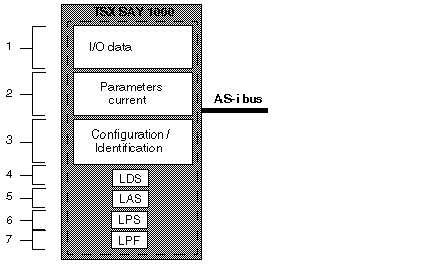The TSX SAY 1000 module operates according to the master/slave mode. The master only controls exchanges on the bus.
The AS-i standard sets several operating levels offered by the master:
-
Profile M0 and M0e - Minimum Master: the master only puts forward the configuration of slaves connected to the bus on power-up, and only input/output exchanges.
-
Profile M1 and M1e - Full Master: this profile covers all the operating functions set by the AS-i standard,
-
Profile M2 and M2e - Reduced Master: this profile corresponds to profile M0 operating functions with a slave-parametering option.
The master profiles with an "e" support extended profiles.
NOTE: The TSX SAY 1000 module has an M2e profile, with the additional option of reading slave and slave channel diagnostics information.
The module includes data fields which are used to manage the lists of slaves and I/O data images. This information is stored in a volatile memory.
Illustration of the architecture
The figure below shows the TSX SAY 1000 module architecture.
Description of constituent elements
The table below shows the different elements that make up the architecture of the TSX SAY 1000 module.
|
Number
|
Item
|
Description
|
|
1
|
I/O data
|
Images of 248 inputs and 186 outputs of AS-i V2 bus.
|
|
2
|
Current parameters
|
Image of parameters of all slaves.
|
|
3
|
Configuration/Identification
|
This field contains all the I/O codes and identification codes for all the detected slaves.
|
|
4
|
LDS
|
List of all the slaves detected on the bus.
|
|
5
|
LAS
|
List of active slaves on the bus.
|
|
6
|
LPS
|
List of slaves provided on the bus and configured by Control Expert.
|
|
7
|
LPF
|
List of slaves having a device fault.
|
